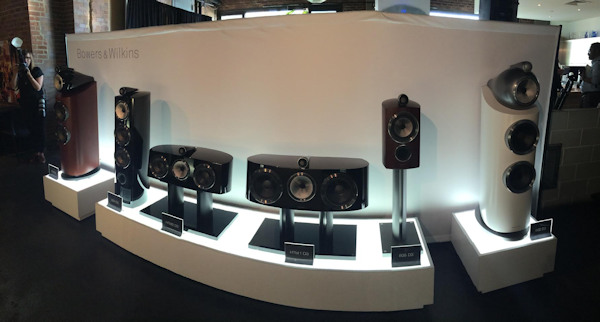
BOWERS & WILKINS PUSHES PHYSICS TO THE LIMITS WITH NEW 800 SERIES DIAMOND LOUDSPEAKERS
Thanks to the weird and wonderful realities of General Relativity, if we were in a theoretical interstellar rocket ship exploring the galaxy, some kooky things would start to happen as we approached the speed of light. The amount of fuel and energy required to reach 95 percent of light speed would pale in comparison to that required to accelerate from 95 to 99 percent of light speed. And that amount would be positively dwarfed by the amount of fuel and energy it would take to accelerate from 99 percent to 99.9 percent of light speed. And to reach 100 percent would, as far as we know based on the laws of physics, be impossible since it would require an infinite amount of energy and fuel.
Mind you, those physical principles aren’t at all the same as the ones that govern speaker design, but there is nonetheless a rough analogy to be made here: if you have a speaker that’s close to perfect to begin with, redesigning it with the goal of getting closer to genuine perfection requires a staggering amount of time and energy—and money.
In the case of Bowers & Wilkins’ new 800 Series Diamond loudspeakers—introduced on Wednesday at an exclusive event at NYC’s Sterling Sound mastering studio—we’re talking about seven years of extensive research and design, as well as millions of dollars spent. All to take what many people consider to be the finest loudspeaker in the world—the speaker found in the most prestigious recording and mastering studios—and make it significantly better.
Those of us gathered at the event got to see firsthand exactly how many of the components in the new 800 Series Diamond D3 lineup carried over from the old. Turns out, you could easily hold those components in one hand, one of them being the diamond tweeter that has been the trademark of Bowers & Wilkins for so long. Turns out, they couldn’t find a way to improve on the tweeter itself. But everything else—from the motor driving that tweeter to the rest of the drivers, the cabinet, the Matrix bracing system inside the speakers—have been completely replaced or redesigned.
Perhaps the most interesting new element is the Continuum driver cone material, which replaces another longstanding B&W trademark: Kevlar. Like Kevlar, the new Continuum material is woven, but that’s pretty much where the similarities begin and end. Continuum is stiffer, for one thing, and features a new aerofoil shape that enhances performance even further.
Lots of work has also been done on the tweeter assembly and the turbine head that houses the midrange driver in the larger speakers in the line. One thing that struck me in particular during the unveiling of the speaker was a demonstration of the startling inertness of the new tweeter assembly. First, the previous tweeter assembly was held up and struck with a bit of metal. It rang out like a bell. Then the new tweeter assembly was given the same smack, and instead of ringing it just sort of went “thnk.” Same for the newly designed speaker basket, the old design of which positively sang when struck. The new one just sort of made a quickly decaying “tk” sound.
What impressed me even more were the animations we viewed showing simulations of the materials in the old and new speaker designs resonating when excited by specific frequencies of sound. The differences were staggering. The old cabinets and internal bracing could be seen wobbling perceptibly under simulated performance conditions, whereas the new designs remained rock solid. So much so that their motions had to be exaggerated so we could see any vibrations at all.
All of which means that the sound delivered by the new 800 Series Diamond speakers contains more music, and less coloration from the speakers themselves. You don’t hear the cabinet or the internal bits and pieces of the speakers; you hear the sound coming from your electronics, and not much more.
We got to hear that firsthand when we entered one of the mastering suites at Sterling Sound, and listened to some tunes via the old B&W 805 Diamond compact speaker, followed immediately by the same selections on the new 805 D3. The differences were immediately apparent. The new 805 D3 was quite noticeably more detailed, more neutral, with better imaging and a sound that penetrated the air in the room more effortlessly. Simply put, I felt closer to the music. The same held true for the new 802 D3, as well. Granted, we were in a world-class sound room, but I was blown away by how immediate, how tactile, how intimate the music sounded. I hate to fall back on banal descriptions like “breathtaking,” but I did notice that those of us in the room were holding our breath just to be able to soak it all in better. So maybe the 802 D3 didn’t quite take our breath, but we gave it willingly nonetheless.
Mind you, as a result of all the innovation poured into these new speakers, prices have gone up just a bit. Pricing for the new speakers and stands is as follows:
- 802 D3: $22,000 pair
- 803 D3: $17,000 pair
- 804 D3: $9,000 pair
- 805 D3: $6,000 pair
- HTM1 D3 (center speaker): $6,000 each
- HTM2 D3 (center speaker): $4,000 each
- FS-805 D3 Floor Stand: $500 each
- FS-HTM D3 Floor Stand $600 each
Unfortunately we’ll have to wait until the spring of 2016 for pricing and specs on the new flagship 800 D3, but if yesterday’s event was any indication, it’ll be worth the wait.
Content courtesy of: Dennis Burger, Editor in Chief, HDLiving.com



